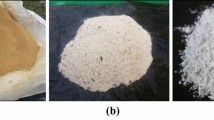Abstract
During the construction of clay core rockfill dam in cold regions in winter, the heat transfer characteristics of gravelly soil are important to the anti-freezing control of the core. Laboratory experiment and field test data showed that the frost depth of gravelly soil in unconsolidated state was deeper than that in compacted state at the early period of soil freezing. With the increase of the freezing time, however, the frost depth of compacted soil is deeper than that of unconsolidated soil. Further study showed that this phenomenon was main caused by the change of thermophysical parameters between unconsolidated and compacted soil. Under the same soil temperature, the thermal conductivity of compacted soil was approximately 2.6 times of that of unconsolidated soil, and the volume heat capacity and phase change latent heat of compacted soil was approximately 1.7 times of that of unconsolidated soil. The different thermophysical parameters caused the differences of the heat transfer rate, temperature distribution and heat release by cooling between compacted soil and unconsolidated soil. This study provides a theoretical guidance for freezing process of soil with different compactness and anti-freezing technology of clay core rockfill dam in cold regions.









Similar content being viewed by others
References
Qi J, Vermeer PA, Cheng G (2006) A review of the influence of freeze-thaw cycles on soil geotechnical properties. Permafrost Periglac 17:245–252
Lai Y, Xu X, Dong Y, Li S (2013) Present situation and prospect of mechanical research on frozen soils in China. Cold Reg Sci Technol 87:6–18
Ma W, Wang D (2014) Frozen soil mechanics. Beijing, China
Wang B, Wang Q, Zhou J (1999) Construction of anti-seepage materials of Xiaolangdi dam in winter. Northwest Water Power 70:36–39
Eigenbrod KD (1996) Effects of cyclic freezing and thawing on volume changes and permeability of soft fine-grained soils. Can Geotech J 33:529–537
Zheng Y, Ma W, Mu Y (2015) Analysis of soil structures and the mechanisms under the Action of freezing and thawing cycles. In: Proceeding of 16th International Conference on Cold Regions Engineering. ASCE, Salt Lake City, p 25–33
Liu JK, Chang D, Yu QM (2016) Influence of freeze-thaw cycles on mechanical properties of a silty sand. Eng Geol 210:23–32
Miao CY, Chen JF, Zheng XQ (2018) Relationship between air temperatures and soil freezing-thawing process. J Taiyuan Univ Technol 49:412–417
Liu GY, Liu CW, Yang SH (2018) Spatial and temporal variation characteristics on the onset dates of freezing and thawing of active layer and its influence factors in permafrost regions along the Qinghai-Tibet Highway. J Glaciol Geocryol 40:1067–1078
Wang QF, Jin HJ, Zhang TJ, Wu QB, Cao B, Peng XQ, Wang K, Li LL (2016) Active layer seasonal freeze-thaw processes and influencing factors in the alpine permafrost regions in the upper reaches of the Heihe River in Qilian Mountains. Chin Sci Bull 61:2742–2756
Jukneviciute L, Laurinavicius A (2008) Analysis of the change in the depth of frozen ground in different soils under Lithuanian conditions. In: The 7th International Conference Faculty of Environmental Engineering Vilnius Gediminas Technical University, Vilnius, pp 1160–1168
Li R, Zhao L, Ding YJ, Shen YP, Du RJ, Liu GY (2009) The effect of global radiation budget on seasonal frozen depth in the Tibetan Plateau. J Glaciol Geocryol 31:422–430
Hu G, Lin Z, Wu X, Wu T, Li R, Xie C, Zou D (2017) A mathematical investigation of the air-ground temperature relationship in permafrost regions on the Tibetan Plateau. Geoderma 306:244–251
Li R, Zhao L, Ding YJ, Shen YP, Du RJ, Liu GY (2009) The climatic characteristics of the maximum seasonal frozen depth in the Tibetan Plateau. J Glaciol Geocryol 31:1050–1056
Zhou Y, Guo D, Qiu G, Cheng G, Li S (2001) Geocryology in China. Beijing, China
Xu X, Wang J, Zhang L (2001) Frozen soil physics[M]. Science Press, Beijing
Zhang Y, Du Y, Sun B (2014) Temperature distribution in roadbed of high-speed railway in seasonally frozen regions. Chin J Rock Mech Eng 33:1286–1296
Yang S, Tao W (2006) Heat transfer. Higher Education Press, Beijing
Acknowledgements
This research was supported by the Second Tibetan Plateau Scientific Expedition and Research (STEP) program (Grant No. 2019QZKK0905), and the Science and Technology Project of Yalong River Hydropower Development Company (Grant No. YLLHK-LHA-2019006).
Author information
Authors and Affiliations
Corresponding author
Ethics declarations
Conflict of interest
On behalf of all authors, the corresponding author states that there is no conflict of interest.
Additional information
Publisher’s note
Springer Nature remains neutral with regard to jurisdictional claims in published maps and institutional affiliations.
Rights and permissions
About this article
Cite this article
Zhang, Z., Yu, Q., Wang, J. et al. Heat transfer characteristics of gravelly soils with different compactness during unidirectional freezing process. Heat Mass Transfer 57, 1161–1170 (2021). https://doi.org/10.1007/s00231-021-03022-z
Received:
Accepted:
Published:
Issue Date:
DOI: https://doi.org/10.1007/s00231-021-03022-z




